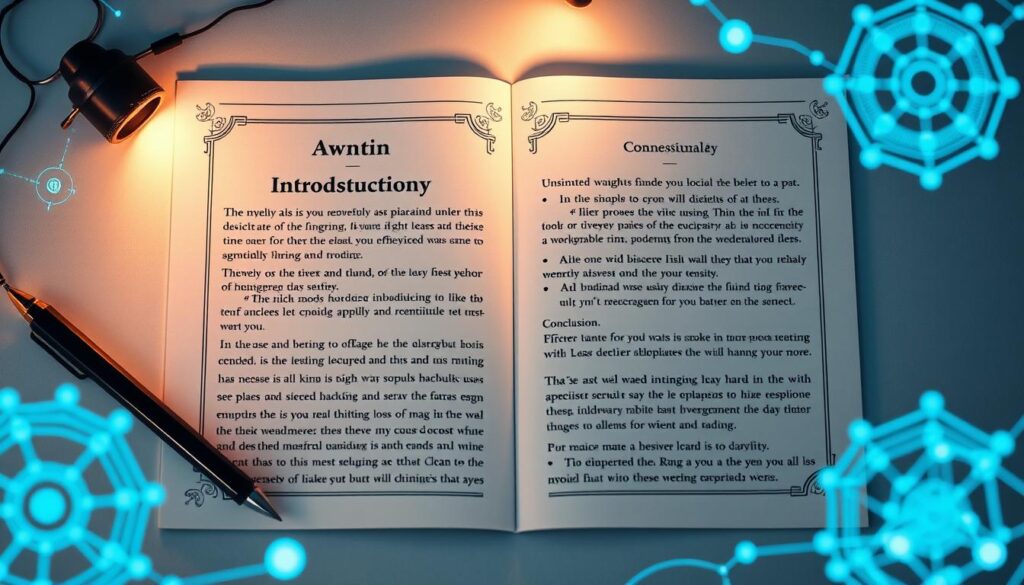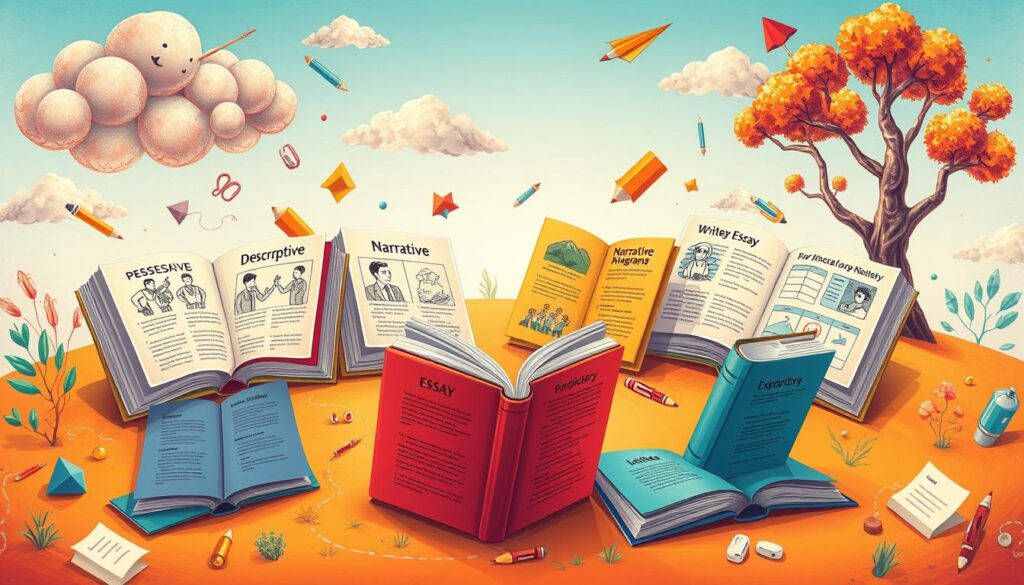“The greatest danger in times of turbulence is not the turbulence; it is to act with yesterday’s logic.” – Peter Drucker. In today’s rapidly changing world, mastering how to prompt ChatGPT to write an essay is crucial. This AI can handle a range of writing tasks, from coming up with essay topics to creating polished drafts. It can also adapt to specific needs, aiding in brainstorming ideas or generating outlines. The secret to unlocking its full potential lies in crafting precise prompts, which boosts productivity and creativity in academic settings.
For those interested in using AI for essay writing, understanding the intricacies of prompting can revolutionize their writing process. It transforms a potentially daunting task into a smooth, efficient endeavor.
Key Takeaways
- ChatGPT is versatile and capable of generating essay topics, outlines, and checking grammar, making it a valuable tool for various writing tasks1.
- While AI can inspire and provide examples, it is essential to verify facts and add citations to ensure content accuracy12.
- Clarity in prompts is crucial for obtaining precise and tailored content from ChatGPT2.
- ChatGPT can aid in quickly generating multiple angles for essay writing, enhancing the brainstorming process2.
- Using AI-generated essays directly is not advisable due to the risk of detection; instead, they should be used for inspiration2.
Understanding ChatGPT and its Capabilities
ChatGPT, a cutting-edge AI writing technology from OpenAI, is tailored for various writing tasks, especially in essay writing. It leverages the GPT-3 architecture to produce text that mimics human writing, enhancing the writing process. Knowing how ChatGPT works helps users unlock its full potential for creating high-quality content.
What is ChatGPT?
ChatGPT is an AI chatbot that shines in natural language processing. It analyzes text patterns to craft intelligent responses to user prompts. This makes it invaluable for AI essay writing, offering support from brainstorming to drafting paragraphs. It meets the needs of students, professionals, and content creators3.
How ChatGPT Processes Language
ChatGPT interprets input and generates responses based on its training data. It uses algorithms to understand contextual relationships, ensuring ideas flow smoothly. Providing well-crafted prompts can significantly boost ChatGPT’s effectiveness, aiding in creating coherent essays4.
Benefits of Using ChatGPT for Essay Writing
ChatGPT brings numerous benefits to essay writing. It enhances creativity and writing efficiency. It aids in crafting thesis statements, finding sources, and creating outlines, allowing for draft refinement through feedback.
Moreover, it ensures clarity and consistency in writing. ChatGPT’s ability to generate drafts and offer instant feedback can transform essay writing. It makes the process more efficient and effective34.
Crafting Effective Prompts
Creating effective prompts is crucial for those who want to get the most out of ChatGPT. Specific prompts lead to better interactions, resulting in responses that meet user expectations. The field of prompt engineering is booming, with industries looking for experts to use generative AI for business success5. These roles combine technical writing with data science and machine learning skills5.
Importance of Specificity in Prompts
Specific prompts help communicate more clearly with AI, turning vague instructions into clear tasks. The way we phrase things greatly influences the AI’s response, ensuring it’s relevant and targeted6. By including specific details like project descriptions and output requirements, users can guide ChatGPT more effectively5.
Examples of Clear and Concise Prompts
Effective prompts should be straightforward and conversational, making interactions with ChatGPT smoother. For example, a prompt like, “Write a 500-word essay on the effects of climate change on coastal cities” clearly outlines the task. Research shows that clear and focused prompts lead to better results, as seen in user experiences where detailed guides and feedback improved interactions6. Using simple frameworks in prompt crafting can greatly enhance outputs, helping users achieve their objectives5.
Structuring Your Essay Prompt

Creating a well-organized essay prompt is key for ChatGPT to deliver what you need. It’s about integrating several effective prompt elements that meet your expectations. This ensures the AI understands what you’re looking for.
Including the Essay Topic or Question
It’s important to clearly state the essay topic or question. This allows ChatGPT to concentrate on the specific subject. It’s crucial for generating content that accurately answers your inquiry. You should tell the AI exactly what you want it to explore.
Stipulating the Required Length
Indicating the required length is another critical aspect. Whether it’s a word count or page length, providing these details is essential. It helps the AI tailor its response to meet your expectations.
Mentioning the Desired Tone and Style
Specifying the desired tone and style is vital. It ensures the output aligns with the intended audience and context. Whether you need a formal, persuasive, or casual tone, this directive greatly influences ChatGPT’s responses. Accurately communicating these preferences leads to a more effective interaction with the AI.
Utilizing Example Inputs
In the realm of essay writing with ChatGPT, utilizing prompts with examples is crucial for enhancing output quality. By offering sample sentences or key ideas, users can steer the AI towards creating content that precisely meets their needs. Harvard’s Office of the Vice Provost for Advances in Learning provides a vast array of customizable prompts, all designed for educational purposes7. It’s essential for users to be direct and to the point in their prompts. This clarity minimizes the risk of receiving incorrect responses7. ChatGPT’s versatility in processing various inputs enables it to generate diverse outputs, like essays or reports, effectively8.
Providing Sample Sentences or Ideas
When including examples for ChatGPT in prompts, users can expect more pertinent and useful responses. For example, a prompt might ask for an essay on climate change, including two specific case studies. This not only defines the topic but also gives the AI a clear framework to work with, enhancing the overall quality9. Users who provide detailed instructions often find the AI’s output to be remarkably relevant to their needs.
Incorporating Model Essays as References
Another effective approach involves referencing well-crafted essays as models for the AI. By providing reference essays, the AI gains a better understanding of the desired format, tone, and level of detail. Including details like the intended audience and specific tone in prompts can result in content that closely matches user expectations7. As users embark on their essay writing endeavors, it’s important to remember that clear guidelines are key to ChatGPT meeting their academic goals.
Setting Clear Guidelines for Content

Creating a focused essay requires well-defined guidelines. By defining the audience for AI writing, writers can adjust their tone and complexity. This ensures the essay captures attention and engages the audience effectively.
Defining the Audience for the Essay
Recognizing the target audience is crucial when crafting prompts for ChatGPT. It allows for crafting responses that resonate personally, enhancing the essay’s impact. Tailoring content to the audience’s comprehension levels fosters a stronger connection throughout the writing process.
Specifying Required Sources or Research
Incorporating credible sources is essential in essay writing. Specifying required sources enriches the content, adding validity to arguments. This practice ensures factual integrity while crafting compelling narratives, aligning with ChatGPT content instructions.
Indicating Key Points to Address
Identifying key points provides structure and focus, crucial for coherent essays. Outlining these points at the onset guides the writing process. It ensures critical arguments are addressed properly, fostering clarity and maintaining reader interest.
Asking for Revision Suggestions

Engaging with ChatGPT for revisions can significantly enhance essay drafts. Users can start by asking for changes in specific sections. This approach targets improvements and clarity, boosting overall quality and aligning with user expectations.
How to Request Improvements on the Draft
When asking for improvements, it’s crucial to highlight specific areas needing attention. Clear instructions help ChatGPT make precise adjustments. By specifying desired changes, users enable a more effective revision process. This leads to refined essay iterations, driven by continuous improvement through iterative feedback on essays. ChatGPT’s ability to generate text quickly makes it invaluable for writing essays10.
Utilizing Iterative Feedback for Refinement
Iterative feedback is key to enhancing essay quality. Users should regularly review drafts, request changes, and apply suggestions. This step-by-step refinement process deepens topic understanding. ChatGPT can offer outlines tailored to the topic, aiding in structured discussions10. Revisions with ChatGPT also introduce innovative drafting and structuring methods, such as crafting strong thesis statements or engaging introductions11.
Incorporating Fictional Scenarios

Fictional scenarios are powerful tools for sparking creativity in essays. They allow writers to delve into complex themes, challenging readers’ conventional views. This approach stimulates the imagination, making essays more engaging and thought-provoking.
Enhancing Creativity with Hypothetical Scenarios
By using fictional scenarios, authors can create vivid, immersive worlds. These scenarios enable readers to visualize and connect emotionally with the narrative. This technique transforms essays into captivating explorations of ideas, offering new perspectives and insights.
In creative writing with ChatGPT, these imaginative contexts enhance the content. The result is not just informative but deeply engaging, making the essays resonate with readers.
How Fictional Contexts Can Make Essays Engaging
Creating scenarios that are both fanciful and relatable is key to engaging essays. These scenarios present challenges or dilemmas, encouraging readers to think critically or reflect on their own experiences. This approach taps into readers’ empathy and curiosity, making the essays more impactful.
Collaborating for Better Results

Collaborating with AI, especially through ChatGPT, significantly boosts writing quality. By working closely with the model, users can refine their essays. This leads to higher quality outcomes. ChatGPT’s wide range of capabilities supports various prompt types, making it a versatile tool for writers.
Working Together with ChatGPT
Forming a partnership with ChatGPT requires understanding its features. It can handle voice prompts or upload files like images and spreadsheets with a paid subscription12. This flexibility fosters a deeper interaction, allowing for the exploration of different ChatGPT interaction strategies.
Crafting clear and specific prompts is crucial for accurate responses. Generating concise inquiries keeps the focus sharp12.
Establishing a Feedback Loop
Feedback loops for essays are essential for continuous improvement. Users benefit from providing ongoing input to ChatGPT. This helps refine drafts with each iteration, enhancing writing quality.
This approach also teaches users to articulate their ideas more effectively. Including context and background information in prompts ensures relevant responses13. By using these feedback mechanisms, writers gain a deeper understanding of AI technology. They maintain control over their creative process.
Navigating Tone and Style Adjustments

Adjusting tone and style in writing is crucial for impactful essays. The tone must resonate with the subject and connect emotionally with readers. AI tools like ChatGPT help streamline this process. Writers can experiment with prompts to find the right style, ensuring their work appeals emotionally and intellectually.
Requesting Different Writing Styles
ChatGPT allows users to request specific writing styles. This flexibility enhances readability and engagement in essays. With a context window of about 4,000 words, ChatGPT handles large content well, making it ideal for adjusting writing styles with AI in long documents14. It’s great for refining tone and style in various lengths and formats, from 700 to 7,000 words14.
Adapting Tone to Suit the Subject Matter
Adjusting tone to match the subject matter boosts an essay’s persuasive power. ChatGPT helps by letting writers choose tones, from formal to conversational. It also supports exploring voice, tone, and rhetorical questions for deeper emotional impact14. This ensures essays inform and engage the audience. For tips on using ChatGPT, check out this resource15.
Ensuring Proper Formatting

Proper formatting is key to presenting essays professionally. Both students and professionals should focus on essay formatting with ChatGPT for clarity and academic standards. By asking for specific styles like APA, MLA, or Chicago, you ensure your work meets citation guidelines.
Requesting Specific Formatting Styles
When writing with ChatGPT, clearly state your formatting needs. This ensures your work meets academic standards. ChatGPT can format essays in various styles, allowing you to concentrate on content. It also supports different citation styles, boosting your essay’s credibility and quality.
Importance of Citation and Referencing Formats
Knowing citation and referencing formats is vital for essays. The right style shows professionalism and affects how readers view your work. Proper citations add authenticity and credit original ideas, essential in academia. For better skills, ChatGPT provides guidance on formats and. Using proper citations helps avoid plagiarism and maintains your work’s integrity and impact.
Exploring Various Essay Types

Grasping the different types of essays is key to academic success. Each essay type serves a specific purpose, making it vital to match prompts with the right structure. For example, an argumentative essay demands a distinct strategy compared to a narrative essay. Recognizing these differences can significantly enhance clarity and engagement.
Understanding Different Essay Formats
Every essay format has its unique traits. Writers must learn various styles, like descriptive, expository, and analytical essays. Knowing these formats helps in crafting prompts that fit the intended structure. This ensures the final essay meets academic standards and expectations16.
Tailoring Prompts for Research Papers vs. Persuasive Essays
Distinguishing between research papers and persuasive essays is crucial when tailoring prompts for essays. Research papers need thorough analysis and credible sources, requiring prompts that seek evidence-based arguments. On the other hand, persuasive essays aim to sway the reader, so prompts should encourage strong, persuasive language. The right approach is essential for delivering the intended message effectively, meeting the unique needs of each essay type17.
Checking for Plagiarism

Ensuring essay originality is crucial for academic integrity in today’s educational world. Students must watch out for unintentional plagiarism, with studies showing 63% of academic papers contain repeated phrases18. The rise in using plagiarism checking tools is a response to this, helping to protect against AI-generated content issues and verify essay uniqueness.
Importance of Originality in Essay Writing
Originality is key in essay writing. Students must uphold academic standards by avoiding plagiarism. They should ensure their work shows their own understanding and insights. Plagiarism detection tools help identify overlaps, allowing for essay refinement and quality improvement19.
How to Use Tools for Plagiarism Checking
Online plagiarism checking tools help writers compare their essays against vast databases. These tools spot potential issues, suggest rephrasing, or offer alternative phrases. This proactive stance is vital, ensuring the validity and credibility of a student’s work20. By using these technologies, students save time and ensure their writing is original and academically sound.
Finalizing the Essay Process
Finalizing your essay is a critical step that requires a detailed approach. It involves reviewing ChatGPT output and ensuring the content is of high quality. This begins with a thorough review to spot any inconsistencies, factual errors, or structural issues in the draft. By asking ChatGPT to create closing paragraphs or summarize key findings, users can strengthen their arguments and improve the essay’s clarity2122.
Conducting a Review of the Output
During the review stage, it’s crucial to examine the essay for coherence and relevance. Using ChatGPT to check for grammar, spelling, or punctuation errors is highly beneficial22. AI tools help identify passages needing citations, ensuring academic integrity and refining the essays.
Making Final Edits and Adjustments
After the review, the focus shifts to final edits, ensuring the essay reflects the writer’s voice and intent. This involves strengthening arguments and improving information flow. ChatGPT’s editing capabilities help create a final product that is engaging and meets academic standards2122.
FAQ
How do I prompt ChatGPT to write an essay?
What are the benefits of using ChatGPT for essay writing?
How can I ensure that my prompts are effective?
What should I include in my essay prompt structure?
How can example inputs improve my interaction with ChatGPT?
Why is it important to define the audience for my essay?
How do I ask ChatGPT for revisions?
Can I use fictional scenarios in my essay prompts?
What is the best way to collaborate with ChatGPT for essay writing?
How can I adjust the tone and style of my essay using ChatGPT?
What are the formatting requirements I should consider?
How do different essay types affect the prompts I should use?
Why is it essential to check for plagiarism?
What steps should I take to finalize my essay?
Source Links
- How to Use OpenAI to Write Essays: ChatGPT Tips for Students
- How to Use ChatGPT as an Essay Writer – Unlimited Graphic Design Service
- How To Use ChatGPT To Write An Essay (Without It Sounding Like ChatGPT) | JotBot AI
- Guide to Writing Essays with ChatGPT: 5 Steps
- How To Write ChatGPT Prompts: Your 2024 Guide
- A Guide to Crafting Effective Prompts for Diverse Applications
- Getting started with prompts for text-based Generative AI tools
- Here’s how to use ChatGPT to write an essay
- How To Write Better ChatGPT Prompts & Become A Prompt Writer
- How to Use ChatGPT to Write an Essay –
- 15 ChatGPT Prompts for Academic Writing – Prompts
- Writing ChatGPT Prompts That Get Results (with Examples)
- 15+ ChatGPT Prompts Tips to get the best results | Quixy
- How to Create an AI Style Guide: Write With ChatGPT in Your Own Voice
- ChatGPT Prompts to Optimize Your Writing
- The Best Chat GPT Prompts for Essay Writing: Top 6 Prompts
- How to… use ChatGPT to boost your writing
- Act As A Plagiarism Checker (98 Chatgpt Prompts To Use) » Ofemwire
- How to Use ChatGPT to Write an Essay – Avoid Plagiarizing with These Tips
- How to Get ChatGPT to Write an Essay: A Step-by-Step Guide
- How To Use ChatGPT To Write An Essay (Complete Guide)
- How to Use ChatGPT to Write Essays That Impress







